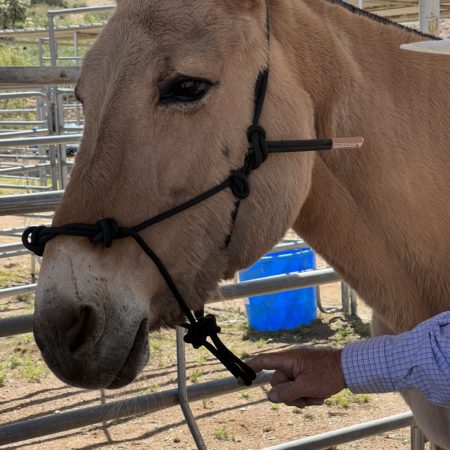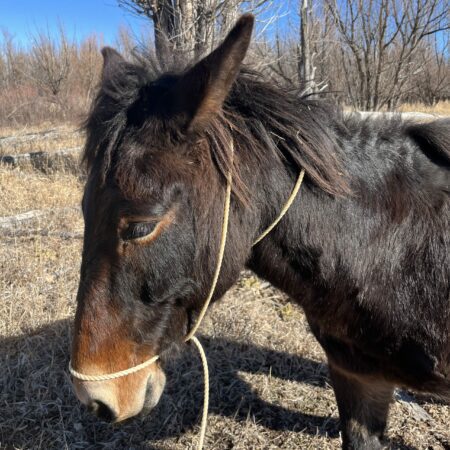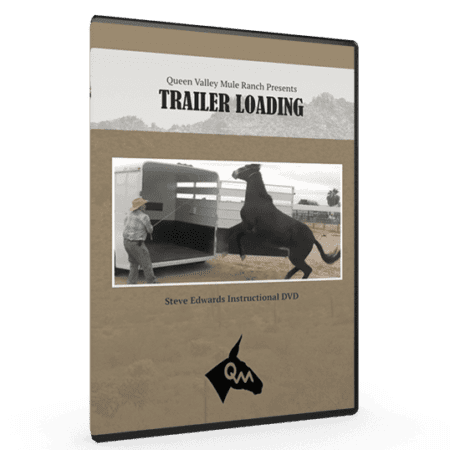Trailer Loading – How to Successfully Load Your Mule or Donkey
Trailer loading is one of the most difficult and dangerous things we do with our animals. If you have a trailer and are constantly on the go – it can be one of the most frustrating activities you encounter if your mule or donkey won’t load willingly.
In this video, Steve Edwards talks through the mistakes folks make with their halter and how it impacts the animals ability or desire to load up in a trailer.
These days we’re taking our animals all over the United States, and we do it by trailer. And I find that the safest trailer that we have today is your slack load trailer. It’s open. Each one of the doors get out of the way. The mule sees lots of room to be able to go in and out. The downside is one day some little problem happens and the mule now is afraid to go in there. That’s when you find out if your mule is truly halter trained, because all of a sudden you start to walk, and all of a sudden the mule says, “I don’t want to go.” So that means your halter must be properly adjusted.
We want to make sure we don’t go past three, so we’re gonna ask, tell, demand. So I’m gonna ask my mule to go forward. That’s my number one step. He starts to go forward but hesitates. Then I’m gonna tell him to go forward, and if he doesn’t want to do it, then I’m doing something incorrectly. Also, it could be that the halter is not adjusted correctly. So I’m going toward the halter. I’m going toward the door, I go off here to the left a little bit, then I go off to the right, then I bump him forward again. Don’t keep on doing it. Don’t come up to the gate, turn around, go back, come up to the gate, turn around. Don’t do that, because you’re giving him what he wants, and that is to leave this spot. He figures this place here is a really uncomfortable place. He’s been hurt in there, something’s gone wrong, who knows whatever it is.
So if you go up to the door, turn around and go back out, you’re giving him what he wants as soon as he turns around. Even if you just tie him to that spot and just leave him there, that’s okay. Guess what? He has to listen to that halter. When he pulls back on the halter, the halter bumps him on the poll. When he goes over to the left, it bumps him on his nose. Bumps over to the right, it bumps him on the nose. If the halter is adjusted correctly, two fingers above the nostril and each knot in the nostril as you’ll see in one of my other videos, he’ll respect the halter.
And remember, no pulling. Always bump, bump, bump. In my video, you’ve seen where I’ve worked with a mule that didn’t want to go in the trailer, and that mule dragged me all over the place. But the end result, the mule went in. You never did see me keep on training and doing the same thing over and over again because if you do it a third time, it now becomes a habit. Now becomes a foundation. So you only do it twice. The demanding only comes in when you’ve done it and the mule knows. Then he says, “I ain’t gonna go,” then you’re gonna go into the demanding stage. But when you’re training, never do it over two times. If you do it over two times, they’re gonna know that that’s a fact for them, and you don’t wanna do that.
So I load him three times, I go put him away. I load him three more times, that’s six. Load him three more times, nine. Three more times, 12. Now I’ve got a foundation. Now if you go up to the gate and he says no, I’m gonna ask him, bump; I’m gonna tell him, bump, bump; and I’m gonna demand upon him, bump, bump, bump, and really make him sore.
So the big thing with trailers is today, trailer is far superior. We have a better axle assembly, we have better roads, we have better pulling things like this. Can some of them get in there and be all sweaty and nervous? Yeah, just like you and I. We’ll get in there and … but I’ve loaded this mule 50 times. No, no, no. You gotta remember that they have hair. They have skin. They have brains. And when something bothers them, that’s the way they’re gonna tell you we got a problem here. So sometimes it just takes to tie them in there and leave them in there.
Okay, Steve, he’s pawing. Take 18 inches of heavy chain, put it on a strap, put it above the knee. When he goes to paw, the chain’s gonna hit him on the cannon bone, gonna make him uncomfortable. When he quits pawing, pull the chain off. Hang it up where he can look at it. And he’s gonna think, “Okay.” When he paws, the chain comes off of here and goes down onto his leg. He’s gonna think, “Aw man, if I paw in this spot …” Are you gonna get him to quit pawing? No. Pawing is part of their life. It’s part of the makeup. If they paw, it’s they want something. This particular case, “I want out of here.” But if you make him uncomfortable, saying, “Okay, you paw, I’m gonna put the chains on.” He’s gonna say, “Oh, okay. In this spot, I don’t paw.” It’s very very important.
Always tie with a quick release. Don’t use those snaps, the quick release snaps. Those things there will make a disaster area. Always use a rope halter. Don’t use nylon halters. Nylon halters brace, make an animal brace. They get where they disrespect the halter. If a properly adjusted rope halter is on that animal like you’re gonna see on my videos here on YouTube, you’re gonna find that when that mule pulls back, that rope halter’s gonna mean more to him than that big web. You’re thinking, “I’ll put the web halter and be nice to him.” No, you’re gonna teach him bad habits is what you’re gonna do. Take that web halter, hang it up on a nail, and just think the past is the past, I’m relieved at last. Be done with it.
Thank you very much. We’ll see you in the future.
-
 Rope HalterRated 4.88 out of 5 based on 32 customer ratings
Rope HalterRated 4.88 out of 5 based on 32 customer ratings -

 Come-A-Long RopeRated 4.99 out of 5 based on 69 customer ratings
Come-A-Long RopeRated 4.99 out of 5 based on 69 customer ratings -

 Trailer LoadingRated 5.00 out of 5 based on 2 customer ratings
Trailer LoadingRated 5.00 out of 5 based on 2 customer ratings
- Posted in: Everything, Videos
- Tagged: Everything, Videos


